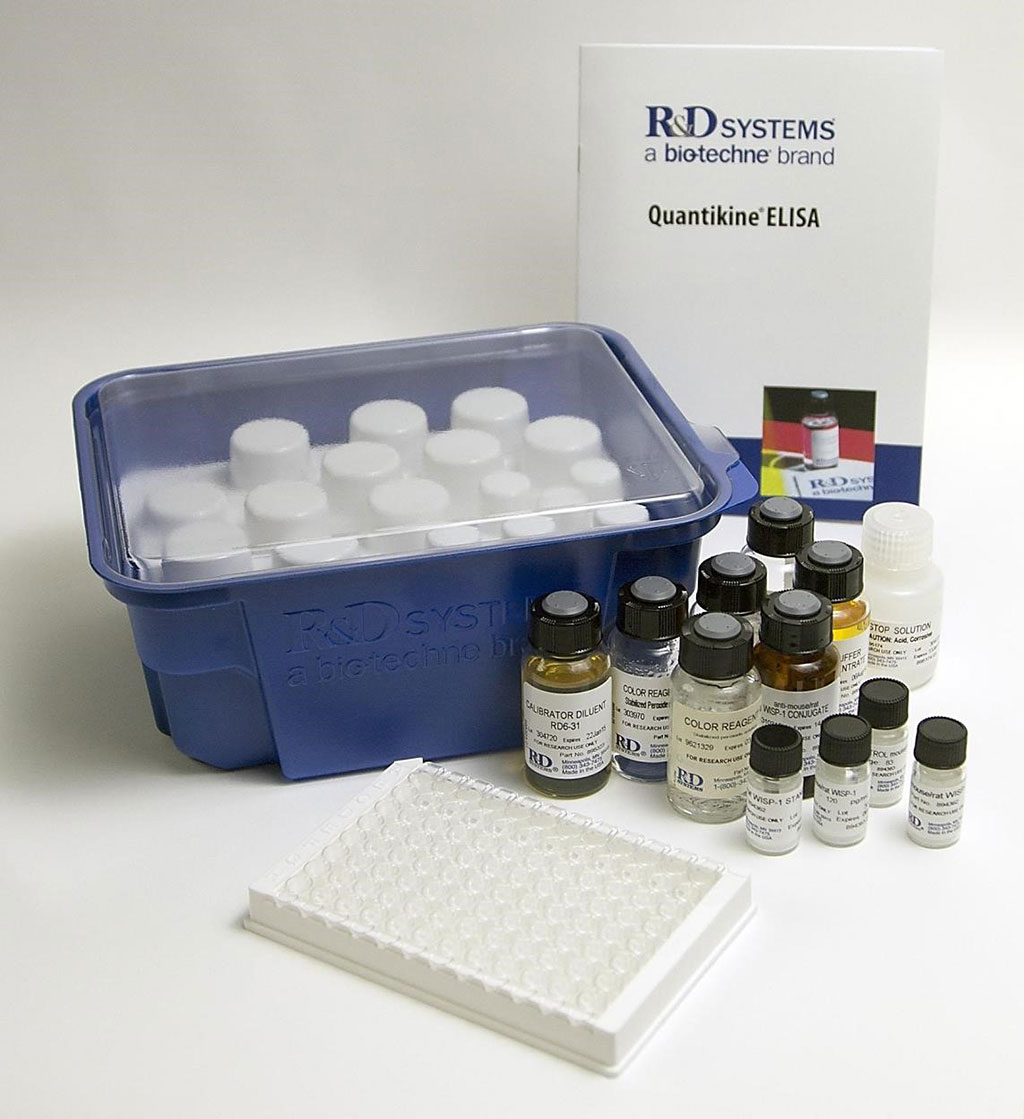Lipocalin 2 Proposed as Biomarker for Bacterial Meningitis
|
By LabMedica International staff writers Posted on 05 Aug 2020 |

Image: The Quantikine ELISA Human Lipocalin-2/NGAL Kit is a solid phase sandwich ELISA that quantifies human Lipocalin-2/NGAL in serum, heparin plasma, saliva, and urine (Photo courtesy of R&D Systems).
Central nervous system (CNS) infections cause significant mortality and morbidity worldwide. Common CNS infections include bacterial meningitis (BM) other than tuberculosis, viral encephalitis, tuberculous meningitis (TBM) and cryptococcal meningitis, but there are more than 100 documented infectious causes of CNS infections.
Clinical features are often insufficient to discriminate the likely cause and standard laboratory investigations identify the causative agent in less than 60% of cases. Critically, the clinical management of CNS infections varies according to its etiology. Therefore, rapid and accurate identification of the likely cause of the infection is essential to initiate appropriate therapy and improve patient outcome.
Scientists from the Oxford University Clinical Research Unit (Ho Chi Minh City, Vietnam) and their associates applied liquid chromatography tandem mass-spectrometry on 45 cerebrospinal fluid (CSF) samples from a cohort of adults with/without CNS infections to discover potential diagnostic biomarkers. They then validated the diagnostic performance of a selected biomarker candidate in an independent cohort of 364 consecutively treated adults with CNS infections admitted to a referral hospital in Vietnam.
Measurement of lipocalin 2 (LCN2) concentrations was performed on CSF samples and a subset of plasma samples of the study participants using monoclonal antibody based Quantikine ELISA kits (R&D Systems, Minneapolis, MN, USA) which costs around USD 10/test. CSF was analyzed as individual samples using proteomic platforms. MS/MS spectra were searched against the UniProt Homo Sapiens Reference proteome. Deamidation on asparagine and glutamine and oxidation on methionine were included as variable modifications.
The team identified LCN2 as a potential biomarker of BM other than tuberculous meningitis. The analysis of the validation cohort showed that LCN2 could discriminate BM from other CNS infections (including tuberculous meningitis, cryptococcal meningitis and viral/antibody-mediated encephalitis), with the sensitivity of 0.88, the specificity equaled 0.91 and the diagnostic odds ratio was 73.8. LCN2 outperformed other CSF markers (leukocytes, glucose, protein and lactate) commonly used in routine care worldwide. The combination of LCN2, CSF leukocytes, glucose, protein and lactate resulted in the highest diagnostic performance for BM (area under receiver-operating-characteristic-curve = 0.96).
The authors concluded that their results suggest that LCN2 is a sensitive and specific biomarker for discriminating BM from a broad spectrum of other CNS infections. A prospective study is needed to assess the diagnostic utility of LCN2 in the diagnosis and management of CNS infections. The study was published on July 10, 2020 in the journal Clinical Microbiology and Infection.
Related Links:
Oxford University Clinical Research Unit
R&D Systems
Clinical features are often insufficient to discriminate the likely cause and standard laboratory investigations identify the causative agent in less than 60% of cases. Critically, the clinical management of CNS infections varies according to its etiology. Therefore, rapid and accurate identification of the likely cause of the infection is essential to initiate appropriate therapy and improve patient outcome.
Scientists from the Oxford University Clinical Research Unit (Ho Chi Minh City, Vietnam) and their associates applied liquid chromatography tandem mass-spectrometry on 45 cerebrospinal fluid (CSF) samples from a cohort of adults with/without CNS infections to discover potential diagnostic biomarkers. They then validated the diagnostic performance of a selected biomarker candidate in an independent cohort of 364 consecutively treated adults with CNS infections admitted to a referral hospital in Vietnam.
Measurement of lipocalin 2 (LCN2) concentrations was performed on CSF samples and a subset of plasma samples of the study participants using monoclonal antibody based Quantikine ELISA kits (R&D Systems, Minneapolis, MN, USA) which costs around USD 10/test. CSF was analyzed as individual samples using proteomic platforms. MS/MS spectra were searched against the UniProt Homo Sapiens Reference proteome. Deamidation on asparagine and glutamine and oxidation on methionine were included as variable modifications.
The team identified LCN2 as a potential biomarker of BM other than tuberculous meningitis. The analysis of the validation cohort showed that LCN2 could discriminate BM from other CNS infections (including tuberculous meningitis, cryptococcal meningitis and viral/antibody-mediated encephalitis), with the sensitivity of 0.88, the specificity equaled 0.91 and the diagnostic odds ratio was 73.8. LCN2 outperformed other CSF markers (leukocytes, glucose, protein and lactate) commonly used in routine care worldwide. The combination of LCN2, CSF leukocytes, glucose, protein and lactate resulted in the highest diagnostic performance for BM (area under receiver-operating-characteristic-curve = 0.96).
The authors concluded that their results suggest that LCN2 is a sensitive and specific biomarker for discriminating BM from a broad spectrum of other CNS infections. A prospective study is needed to assess the diagnostic utility of LCN2 in the diagnosis and management of CNS infections. The study was published on July 10, 2020 in the journal Clinical Microbiology and Infection.
Related Links:
Oxford University Clinical Research Unit
R&D Systems
Latest Microbiology News
- High-Accuracy Bedside Test to Diagnose Periprosthetic Joint Infection in Five Minutes
- Innovative Diagnostic Approach for Bacterial Infections to Enable Faster and Effective Treatment
- Non-Invasive Stool Test to Diagnose Endometriosis and Help Reduce Disease Progression
- Automated Positive Blood Culture Sample Preparation Platform Designed to Fight Against Sepsis and AMR
- Revolutionary Molecular Culture ID Technology to Transform Bacterial Diagnostics
- New Digital PCR Assays Enable Accurate and Sensitive Detection of Critical Pathogens
- Rapid Diagnostic System to Deliver Same-Shift Antibiotic Susceptibility Test Results
- AST System Delivers Actionable Results for Gram-Negative Bacteria Directly from Positive Blood Cultures
- Ultra-Rapid Culture-Free Sepsis Test Reduces Testing Time from Days to Hours
- New Rapid Method for Determining Virus Infectivity Could Revolutionize Response to Future Pandemics
- Novel Molecular Test to Help Prevent and Control Multi Drug-Resistant Fungal Pathogen in Healthcare Settings
- Innovative C. Difficile Diagnostic Test Provides Both GDH and Toxin Results within 30 Minutes
- Rapid UTI Test Cuts Detection Time from 3 days to 45 Minutes
- POC STI Test Shortens Time from ED Arrival to Test Results
- Integrated Solution Ushers New Era of Automated Tuberculosis Testing
- Automated Sepsis Test System Enables Rapid Diagnosis for Patients with Severe Bloodstream Infections
Channels
Molecular Diagnostics
view channel
Respiratory Panel to Help Clinicians Make Precise Treatment Decisions in Outpatient Settings
Respiratory tract infections are the primary reason for visits to emergency departments and subsequent hospitalizations. In the U.S., it is estimated that there are up to 41 million cases of influenza... Read more
Integrating Cardiovascular Risk Biomarkers Aids in Detection of ‘Inflammaging’
Cardiovascular diseases (CVD) continue to be the leading cause of death globally, responsible for nearly one-third of all fatalities worldwide. Traditionally, risk assessment for CVD has focused on well-established... Read more
Genetic Signature in Newborns Predicts Neonatal Sepsis Before Symptoms Appear
Neonatal sepsis, which occurs due to the body’s abnormal response to severe infection within the first 28 days of life, results in approximately 200,000 deaths globally each year. This condition affects around 1.... Read more.jpeg)
Integrating Multiple Protein Markers Predicts Health Outcomes in Chronic Kidney Disease Patients
Previous attempts to discover novel kidney biomarkers as risk factors for chronic kidney disease (CKD) progression have generally focused on evaluating proteins individually, which limits their prognostic... Read moreHematology
view channel
Next Gen CBC and Sepsis Diagnostic System Targets Faster, Earlier, Easier Results
Every hour is critical in protecting patients from infections, yet there are currently limited tools to assist in early diagnosis before patients reach a hospital. The complete blood count (CBC) is a common... Read more
Newly Discovered Blood Group System to Help Identify and Treat Rare Patients
The AnWj blood group antigen, a surface marker discovered in 1972, has remained a mystery regarding its genetic origin—until now. The most common cause of being AnWj-negative is linked to hematological... Read more
Blood Platelet Score Detects Previously Unmeasured Risk of Heart Attack and Stroke
Platelets, which are cell fragments circulating in the blood, play a critical role in clot formation to stop bleeding. However, in some individuals, platelets can become "hyperreactive," leading to excessive... Read moreImmunology
view channel
Computational Tool Predicts Immunotherapy Outcomes for Metastatic Breast Cancer Patients
Immunotherapy aims to enhance the body’s immune response to target cancer cells, but not all patients experience a positive reaction to such treatments. Identifying which patients will benefit from immunotherapy... Read more
Biomarker Could Predict Immunotherapy Response in Liver Cancer
Until recently, patients diagnosed with hepatocellular carcinoma had limited treatment options, with existing therapies extending life by only a few months. Immunotherapy has emerged as a new alternative... Read more
Epigenetic Test Could Determine Efficacy of New Immunotherapy Treatments Against Multiple Myeloma
Multiple myeloma is a blood cancer that primarily affects individuals over the age of sixty, and its occurrence rises as the population ages. In this disease, the bone marrow—the spongy tissue inside bones... Read moreMicrobiology
view channel
High-Accuracy Bedside Test to Diagnose Periprosthetic Joint Infection in Five Minutes
Periprosthetic joint infection (PJI) represents a significant global issue that is worsening as the number of joint replacements increases due to aging populations. In the United States alone, the anticipated... Read more_1.jpg)
Innovative Diagnostic Approach for Bacterial Infections to Enable Faster and Effective Treatment
For patients with bacterial infections, timely treatment with the appropriate antibiotics significantly improves their chances of recovery. Current methods for identifying which antibiotics will be effective... Read more
Non-Invasive Stool Test to Diagnose Endometriosis and Help Reduce Disease Progression
Endometriosis, a painful condition impacting nearly 200 million women globally, occurs when tissue similar to the lining of the uterus grows outside its usual location, such as on the intestines or the... Read more
Automated Positive Blood Culture Sample Preparation Platform Designed to Fight Against Sepsis and AMR
Delayed administration of antibiotics to patients with bloodstream infections significantly increases the risk of morbidity and mortality. For optimal therapeutic outcomes, it is crucial to rapidly identify... Read morePathology
view channel
New Imaging Method Opens Door to Precision Diagnostics for Head and Neck Cancers
Head and neck cancers, while considered rare, represent a significant portion of cancer cases and have seen a notable increase over the past 30 years. These cancers encompass various malignant tumors that... Read more
Faster Measurement of Vibrational Fingerprint of Molecules to Advance Biomedical Diagnostics
Identifying different types of molecules and cells is a vital process in both basic and applied science. Raman spectroscopy serves as a widely utilized measurement technique for this purpose.... Read moreTechnology
view channel
New Noninvasive Methods Detect Lead Exposure Faster, Easier and More Accurately at POC
Exposure to lead can negatively affect health in multiple ways, leading to damage in the brain and central nervous system, delays in development and growth, learning and behavioral issues, problems with... Read more
Noninvasive Test Detects Malaria Without Blood Sample
Malaria remains a significant global health issue, with approximately 250 million cases and over 600,000 deaths reported annually. Nearly half of the world's population is at risk for malaria infection,... Read moreIndustry
view channel
Beckman Coulter Partners with BioPorto for Global Distribution of Acute Kidney Injury NGAL Tests
Acute kidney injury (AKI) is a sudden episode of kidney failure or damage that can occur within a few hours or days. This condition leads to the accumulation of waste products in the blood and disrupts... Read more_1.jpg)
CACLP 2025 New Date and Venue Announced
The 22nd China International In Vitro Diagnostic Expo, organized by the China Association of Clinical Laboratory Practice Expo (CACLP, Shanghai, China), is set to take place from March 21 to 24, 2025,... Read more
Roche to Develop New Diagnostic Technologies for Traumatic Brain Injuries
Traumatic brain injuries (TBI) represent a significant global health issue, affecting approximately 69 million people each year. TBI occurs when an external force disrupts normal brain function, with severity... Read more















